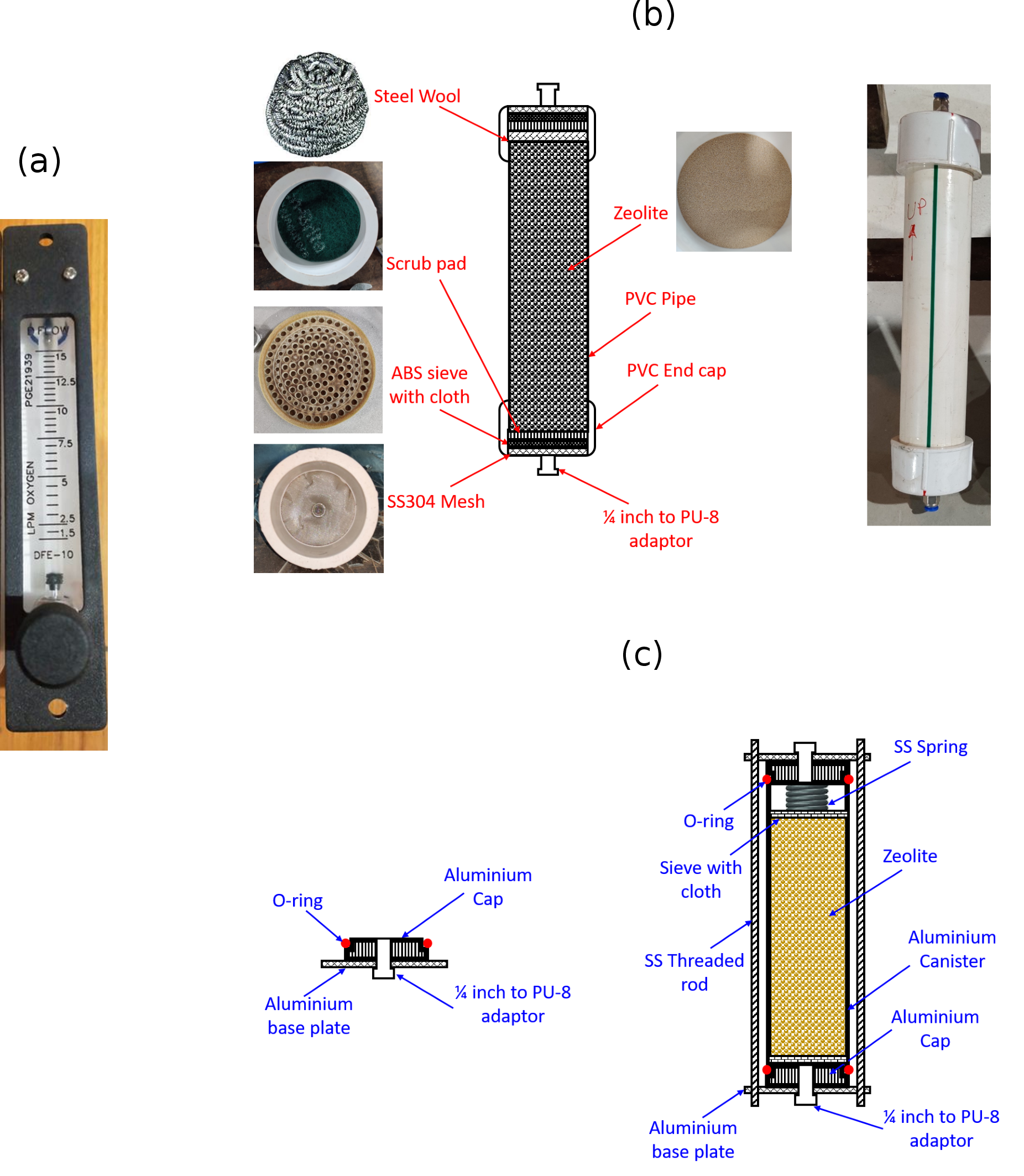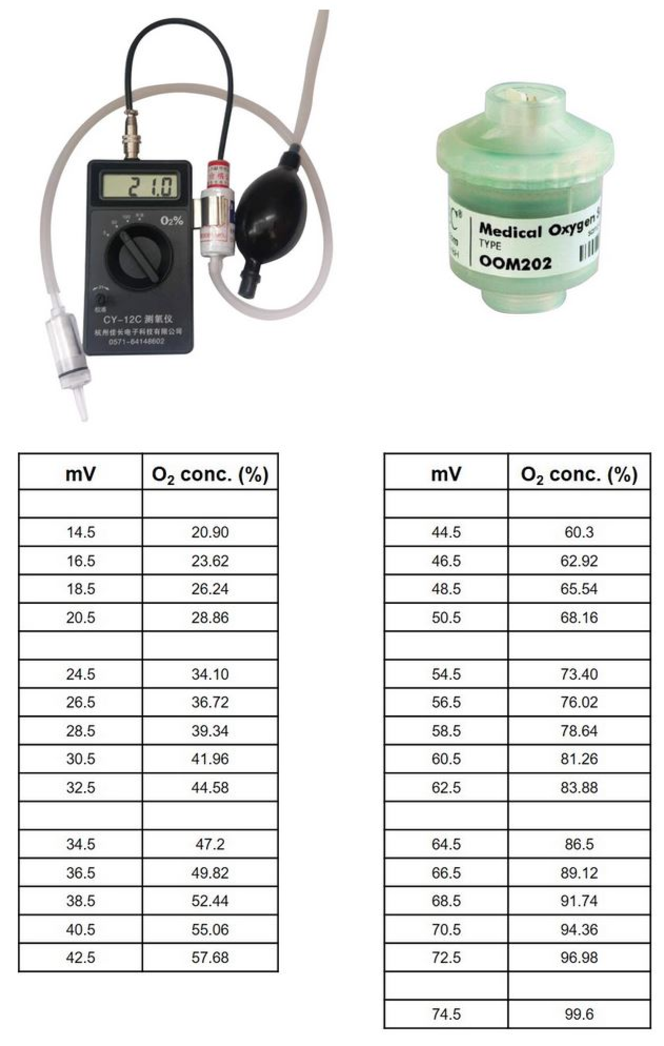Background
The 2nd wave of the COVID-19 virus has exposed a host of supply chain and production issues pertaining to medical oxygen. One of the most important measure to be taken for a COVID-19 affected patient is breathing in high-purity oxygen. While there are small oxygen concentrators in the market, the price point of even cheaper Chinese products is rather prohibitive and is upwards of Rs. 60,000.00. In view of this, we have designed and tested an oxygen concentrator design which is scalable. The purpose of the document is to enable manufacturers and suppliers to develop an ecosystem for component supply and/or development of the entire product.
Process
In the above schematic, compressed air is fed into a set of two parallel lines, one of which is open at any instant of time. The two lines contain a 3/2 solenoid valve, silica packed bed, and LiX zeolite bed. In general, sodium zeolite may also be employed for this purpose. This typically entails a larger mass of zeolite and larger flow rate for the same oxygen outlet flow rate. The downstream section of the two parallel lines are connected by means of a direct acting solenoid valve. The downstream section of each line also contains a non-return valve and flow control valve. The NRV and needle valves are required for appropriate flow separation of the flow going into the oxygen receiver and the purging zeolite canister. Further downstream, there is a surge tank (oxygen receiver) and a rotameter. A tee separates the flow into the main product gas (which can be sent to a purifying section) and a sensor line for monitoring.
Construction Below, we elucidate some of the steps taken in order to construct such a device.
Pneumatics
In order to maximize reliability, high quality pneumatics are desired, such as those
manufactured by Festo. All the threaded connections are 1/4” BSP while
all the push-fit connectors are for an 8mm OD tube. For convenience, we
mention that the drill and tap size for the 1/4” BSP threads is 7/16” drill and
G1/4” tap. The rotameter has an appropriate rating; in this case it is 10 lpm
maximum flowrate. We have employed a rotameter as shown in the figure.
For best performance, reputed brands such as Festo are recommended for
use.
For the assembly of zeolite canister for 10 LPM O2 flow rate, one needs the following:
1) 3.5 inch PVC pipe of 725 mm long along with end caps - Qty. 2 2) 1/4 inch to PU-8 tube connectors - Qty. 4 3) SS304 mesh of US mesh size 100 (cut exactly to snugly fit the end cap) - Qty. 4 4) ABS porous sieve - Qty. 4 5) Scrub pad (cut exactly to snugly fit the end cap) - Qty. 4 6) Piece of cloth (cut exactly to snugly cover the ABS sieve) - Qty. 4 7) Steel wool - Qty. 2 8) Teflon tape and PVC adhesive 9) LiX Zeolite 0.4-0.8 mm particle size (we have used Cilicant M101)

Assembly of Zeolite canister (see above figure for reference):
The downside of the PVC canister is the fact that once sealed, it cannot be reopened for swapping out the zeolite. In this case, aluminium canisters with sealed end caps, with the entire assembly held together by threaded rods, can be utilized. The steps for construction of such a canister, see image above, are mentioned below. The end caps are fabricated from aluminium such that the collar fits the inside diameter of the aluminium tube. At the bottom of the collar is an o-ring such that the aluminum cylinder rests on it and presses on it when the threaded rods are tightened. In our case, we have utilized a tube of diameter 2.5” and length 50 cm. The wall thickness is 3mm.
Controls
We provide herewith two codes to be used with the hardware proposed above.
Arduino code to be used with a keypad
Arduino code with hardcoded times
The circuit schematic and the renders of the PCB and their physical photograph is also shown in the figure below.
Sensors

For intermittent testing, the affordable and portable sensor-analyzer unit CY-12C is utilized. For continuous monitoring, the Honeywell OOM202 sensor is used. The sensor is used in conjunction with an Analog to Digital Converter (ADC). In general, it is possible to utilize the on-board ADC of the Arduino Uno to read the Oxygen level. For higher precision, it is recommended to use a dedicated ADC chip such as the 16bit ADS1115.
Acknowledgments
The work at IIT Kharagpur has been undertaken by Aditya Bandopadhyay (Mechanical Engineering Department), Dr. Sourav Mitra (Mechanical Engineering Department), and Prof. Manoj Mondal (Rajendra Mishra School of Entrepreneurship) and has been made possible through the generous and timely funding received from the IIT Foundation in USA in memory of AK Singh (Batch of 1993), and from Mrs. K. V. S. Jagdamba, wife of Prof. Mondal.
Disclaimer
Disclaimer of Medical Liability. WE, THE UNDERTAKERS OF THIS WORK ON KGP-O2 OXYGEN CONCENTRATOR DESIGN AND MANUFACTURE, DO NOT PROVIDE MEDICAL ADVICE. The contents of the Site are for general informational purposes only. The content is not intended to be a substitute for professional medical advice, diagnosis, or treatment. Reliance on any information provided on the Sites is solely at your own risk. Individual medical needs are very different; you should not assume that the information on the Sites concerning certain courses of treatment or outcomes will apply to you. Rather, you should evaluate your medical condition and make treatment decisions based upon consultation with your physician.
The contents of the Sites may be of interest to medical professions or other health care providers. Medical professionals and health care providers should exercise their own judgment in determining whether a particular product or procedure is appropriate for their practice or their patients.
IIT Kharagpur and the makers of the KGP-O2 oxygen concentrator make no warranties, expressed or implied, including, but not limited to, any implied warranty of fitness of KGP-O2 oxygen concentrator except for usage for COVID 19 purposes and in accordance with the prescribed standards.
IIT Kharagpur and the makers of the KGP-O2 oxygen concentrator shall not be held responsible for for any inappropriate use and/ or misuse of the KGP-O2 oxygen concentrator by the user and any resultant effect/ impact/ injury.